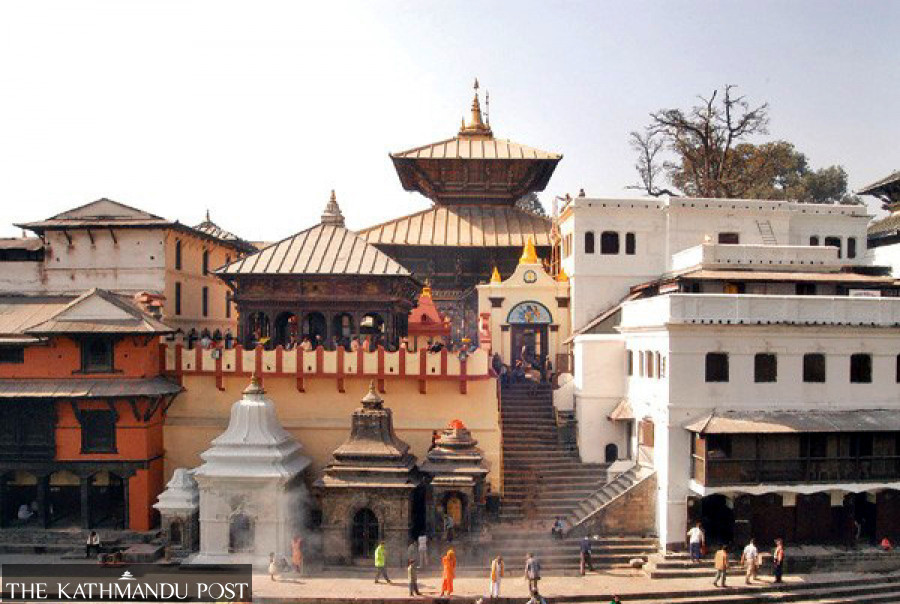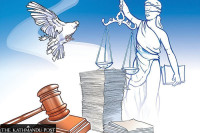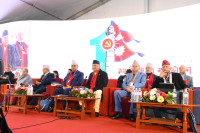National
Heritage activists welcome anti-corruption body probing Pashupati jalahari installation
In February, the Pashupati Area Development Trust had replaced the receptacle at the base of the Shiva Linga with a golden 96-kg one inside the temple defying a court order.
Anup Ojha
After the Commission for Investigation of Abuse of Authority’s letter to the Pashupati Area Development Trust earlier this month to submit details of the installation of a golden jahalari at the Pashupatinath Temple suspecting financial irregularities in the process, locals and heritage activists have welcomed the move and asked the commission to look into the issue minutely.
The commission in the first week of July wrote to the Trust demanding details of the gold procurement and the jalahari installation, which was opposed by locals and heritage activists.
Despite widespread criticism from locals and conservationists the trust had replaced the silver jalahari, a receptacle at the base of the Shiva Linga for collecting the water offering, with a golden 96-kg one inside the temple. President Bidya Devi Bhandari had unveiled the new Jalahari on February 25 a few hours after the Supreme court had ordered a stay of the installation process.
“It’s a good move by the Commission to seek details of the installation process. They should investigate the issue minutely because the Trust installed the jalahari unilaterally and there might have been corruption involved,” said Narottam Baidya, an assembly member of the Bagmati Province and a former treasurer of the Trust.
He also criticized the government for spending millions on the jalahari when the country needed funds for buying vaccines.
In January, former Prime Minister KP Sharma Oli had announced to provide Rs 300 million to the temple to install a golden jahalari and the Ministry of Culture had accordingly released the amount. Observers had said Oli’s announcement was part of his move to placate the Hindu constituency.
Later in February, Baidya and Nikita Dhungana had filed a petition challenging the government decision to replace the jalahari. The petitioners had named the then Prime Minister Oli, who was an ex-officio patron of the trust, then minister for culture Bhanu Bhakta Dhakal, member-secretary of the trust Pradeep Dhakal and Guthi Sansthan, as defenders.
Stakeholders say the Trust didn’t invite any of them to witness the gold-melting, jalahari-making and installation processes so there could have been irregularities.
Dinesh Kumar Dangol, the chairman of ward-8 where the Pashupati area falls, welcomed the Commission’s decision to investigate the process. “The trust has been making crucial decisions unilaterally for the past four years and they didn’t consult us stakeholders while replacing the jalahari,” said Dangol.
Meanwhile, Kedar Man Bhandari, chairperson of the Pashupatinath Sewak Sangh, also one of the priests at the temple, said, the jalahari was installed in a haste and the poor workmanship is evident from the fact that it does not fit properly.
“Since it was taxpayers’ money, the trust should have been transparent throughout the process including where did they buy the gold from and how was the jalahari made among other things. The entire process is fishy,” said Bhandari.
When asked about the complaints, Dhakal, the member secretary of the trust, said his office had already submitted the documents to the Commission two weeks ago. He admitted that they could not install the jalahari properly due to the court order to stop the installation.
“The jalahari was installed in the presence of Nepal Army guards. We will soon organize a press conference and give all the details of the process,” said Dhakal.
Heritage activists and locals, however, do not buy Dhakal’s arguments and accuse the Trust of committing financial irregularities in the process.
“The anti-corruption commission should carry out a thorough investigation and punish all those involved in financial embezzlement,” said Ganapati Lala Shrestha, a heritage activist.




 11.12°C Kathmandu
11.12°C Kathmandu.jpg)















